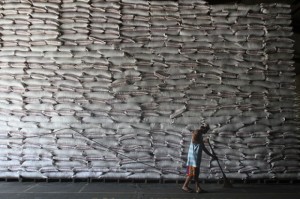Lifting of cap on rice imports pushed

The country’s chief economist is pushing for the removal of the import cap on rice to bring down prices and make the commodity more accessible to the poor.INQUIRER FILE PHOTO/JOAN BONDOC
MANILA, Philippines–The country’s chief economist is pushing for the removal of the import cap on rice to bring down prices and make the commodity more accessible to the poor.
Economic Planning Secretary Arsenio M. Balisacan, who is also director general of the National Economic and Development Authority (Neda), partly blamed high rice prices for the increased poverty incidence recorded during the first half of 2014.
The Philippine Statistics Authority (PSA) reported last Friday that the poverty incidence among individual Filipinos rose by 1.2 percentage points year-on-year to 25.8 percent during the first six months of last year. The poverty incidence among Filipino families likewise inched up by 1.2 percentage points to 20 percent in the same period.
Balisacan pointed out that despite a 6.4-percent year-on-year increase in per capita income during the first semester of 2014, high food prices, especially of rice, eroded the spending capacity of poor Filipinos. Rice accounted for a fifth of low income families’ budgets, the Neda chief noted.
As the government imposes a quota on rice imports, domestic prices are vulnerable to shocks resulting from meager supply.
Article continues after this advertisementDuring the first half of last year, rice inflation jumped by a faster 11.9 percent from just 1.7 percent in the previous year as lean harvests on top of meager importation resulted in a tight supply of the commodity.
Article continues after this advertisementThe World Trade Organization last year allowed the Philippines to extend its quota system or so-called quantitative restriction (QR) until 2017 in a bid to buy time for local farmers to prepare for free trade in light of the government’s goal of achieving self-sufficiency in rice production.
The extended QR currently being implemented by the Philippines slaps a 35-percent duty on imported rice under a minimum access volume (MAV) of 805,200 metric tons. Importation outside of the MAV limit are levied a higher tariff of 50 percent.
Last month, the state-owned National Food Authority (NFA) announced plans to import a total of 500,000 tons of milled rice to augment locally grown stock in the lean season that starts in July.
According to the NFA Council, it would call for tenders for up to 250,000 tons at 25-percent broken and up to 250,000 tons 15-percent broken—both of well-milled, long grain white rice.
The transaction will be made government-to-government. Based on agreements entered into by the Philippines in relation to rice supplies, the possible suppliers are Thailand, Vietnam and Cambodia. Each supplier should offer at least 50,000 for each variety.
The NFA said half of the volume awarded must be delivered not later than March 31 and the remainder should be in by April 30.
According to the PSA, the NFA’s inventory as of Jan. 1, 2015, was 520,000 tons—of which 97 percent was imported.
The NFA started the year with a rice inventory good for 15 days of consumption, meeting its mandated minimum supply.
According to the Food and Agriculture Organization, the Philippines is expected to again import 1.8 million tons of milled rice this year amid projections that growth in domestic production would be insignificant if not nil.